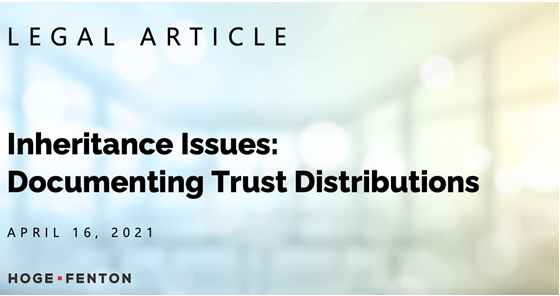Inheritance Issues: Documenting Trust Distributions
By Denise E. Chambliss, Dennis S. Zell | 04.16.2021 | Estates and Trusts

When someone passes away, their trust document describes how and to whom they would like their assets distributed. Unfortunately, despite having a trust in place, there may still be disputes about how those assets are handled. These disputes can be minimized by following best practices for distributing the trust’s assets.
This article is helpful for people who are trustees, have complex estates themselves and people who are (or could be) beneficiaries of trusts.
Hoge Fenton is one of the few law firms with expertise in trust and estate planning, tax planning, and trust and estates dispute resolution. Our team of experts gives us a unique perspective on avoiding disputes.
First, let’s review two terms:
- A beneficiary is a person looking to get distributions or assets from the trust.
- A trustee could be a family member trustee, institutional trustee, or private fiduciary acting as a trustee. The trustee must act in the best interest of the beneficiaries.
We routinely meet with trustees who comes to us when their trust administration is in trouble: beneficiaries are disputing the trust, and the trustee themselves are being sued. Many of these cases could have been avoided if the trustee had utilized best practices when distributing the trusts’ assets.
Beginning the Distribution of the Trust
Option 1: Do the Minimum
In some situations, distribution of a trust simply involves distributing money to the beneficiaries. The advantage of this approach is that it’s easy: the trustee cuts the checks and the beneficiaries cash the checks. This works well for a small estate with a close family who trusts each other and are communicating well. The adage of “let sleeping dogs lie” applies in this case.
The downside of this minimal approach is that the trustee does not know if anyone objects until the distributions are made. Beneficiaries can sue the trustee and other beneficiaries long after the assets have been distributed. Among other remedies, they can deny the trustee compensation, put a lien on property, or sue the trustee for damages, including 10% interest.
Option 2: Best Practices
Communication
A more prudent approach for the trustee is to take steps to protect themselves from legal action and to reduce the risk of arguments over how the assets are distributed. Good communication is important to protect the trustee and to reduce the risk of disputes. It is also the trustee’s duty. People hire lawyers when they’re scared that they’re not going to get what’s coming to them or angry because they think they’re being cheated.
Distribution Receipts
As a trustee, get some form of documentation when distributing assets. That way, in case you are sued, there is a clear paper trail of what was done. Especially when distributing personal property items, get a receipt! The distribution receipt can be as simple as a one line description with a sign-off. But often you can (and should) add a waiver and accounting to help protect the trustee against future risk. Waiving an accounting is appropriate when everyone trusts each other and they don’t want to spend the money on formal legal accounting. The receipt is essential for personal property: how else can you prove you gave somebody something if they didn’t sign a receipt?
A receipt also makes sense if you’re a beneficiary because it clearly shows what you received. Assets can be distributed quickly, and small valuables tend to be forgotten. Family jewelry is an excellent example. Beneficiaries may not remember a piece of jewelry until they see you wearing it at Thanksgiving. The distribution receipt proves that you’re the legitimate owner.
Invite Objections
The best and easiest way to find out if anyone objects to the distribution plan is to ask them (in writing) in advance of distribution. Asking can be as simple as sending an email or a letter. If you call or meet, make sure you follow up with an email or letter to document the conversations. The probate code has a provision confirming the trustees’ right to seek beneficiary approval. If beneficiaries question this approach, you can let them know that it’s your legal right as a trustee and it’s a best practice.
Timing of the Distributions
One of the most common concerns during trust administrations is the timing of distribution, specifically, “Why is it taking so long?” The beneficiary is usually not aware of the trustee’s duties, such as paying the creditors and paying taxes. A trustee has reasonable discretion to delay distribution. That being said, beneficiaries may be anxious during this time because they don’t have their items of value. Therefore, the trustee should communicate regularly about the status of the distribution. If distribution is being delayed due to a creditor’s claim or tax issue, simply let the beneficiaries know.
The other common concern beneficiaries have is the reserve: “Everything’s done, the creditors are paid, why don’t you distribute all of the money?” Best practice in a trust administration is to keep a reserve in case the IRS does an audit or if a dispute arises within the statute of limitations. The amount of the reserve depends on the situation. It’s a good idea to discuss this with a lawyer.
Notice of Proposed Action
There is a procedure called a “notice of proposed action.” This can be used when a beneficiary is unhappy. The conversation might go something like:
Beneficiary: “It isn’t fair.”
Trustee: “What isn’t fair?”
Beneficiary: “I don’t know, it’s just not fair.”
Sending a notice of proposed action encourages the beneficiary to seek legal counsel from an attorney who can articulate the objection or confirm that the beneficiary had no specific objection. Although useful, it’s a time-consuming procedure with certain limitations. For example, it is typically limited to financial transactions, including allocations for distribution and allocation of income. A trustee should consult with an attorney before using this procedure.
If the beneficiary ever gets a notice of proposed action, they should take it to a lawyer immediately because that means that there’s a dispute. You want your own independent lawyer to review it right away.
If there is an objection, the probate code has a procedure called a “petition for instructions.” It’s fairly easy to put together. You file a petition with the Court saying, “Here’s the trust. Here’s what we think it means. Here’s what this other beneficiary thinks it means. Judge, please tell us who’s right because we want to do things by the book.” This is a useful procedure because you are asking the Court to definitively resolve the dispute. Everyone has an opportunity to be heard, the Court makes the call, and then the trustee simply follows the Court’s instructions.
The Trust Distribution Agreement
Our philosophy is that an ounce of prevention is worth a pound of cure. The trust distribution agreement is a sophisticated tool that does just that. It is another form of communication identifying who is the trustee (if it’s a single trustee) or identifying who is doing what (co-trustees). The agreement outlines the assets, the provisions of the trust, where assets are going, and asks for consent from the beneficiary. The agreement documents the administration of the trust so everybody knows what’s going on and they’re all in agreement. In addition, this agreement typically includes a release of liability for the trustee. This helps keep the dispute or a whole administration out of court, prevents the trustee from getting sued for breach of fiduciary duty and minimizes potential disputes and conflicts. The trust distribution agreement has many benefits, but it isn’t easy to find a high-quality template or sample online.
The good news is that 95% of trust dispute cases that are litigated in court amongst beneficiaries will settle out of court via mediation. Mediation avoids the expensive costs of going to trial and lowers the transaction costs of resolving disputes. And that puts more money in the beneficiaries’ pockets. In addition, cases the do get to Court are often referred out to mediation anyway.
Hoge Fenton is well-positioned to help with your sophisticated trust. You have a complex estate. You have a business. You have many beneficiaries. There are tax implications.
If you’re a beneficiary or trustee we have attorneys who can provide you with advice and representation for your trust administration.
 |
 |
| Denise E. Chambliss
Trust & Estate Litigation Chair D: (925) 460-3364 |
Dennis S. Zell
Counsel D: (408) 947-2419 |
This information is provided as an educational service by Hoge Fenton for clients and friends of the firm. This communique is an overview only, and should not be construed as legal advice or advice to take any specific action. Please be sure to consult a knowledgeable professional with assistance with your particular legal issue. © 2021 Hoge Fenton











